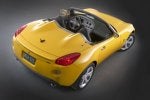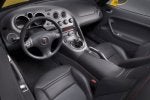Released for press as of today, the official GM information about the Solstice GXP and it's all new 2.0L Turbocharged ECOTEC engine.
http://media.gm.com/us/gm/en/news/events/autoshows/06la/brands/pontiac/06_LA_Pon_SolsticeGXP.htm
http://media.gm.com/us/gm/en/news/events/autoshows/06la/brands/pontiac/06_LA_Pon_SolsticeGXP.htm
PONTIAC REVEALS SOLSTICE GXP PERFORMANCE VARIANT AT 2006 LA AUTO SHOW
LOS ANGELES – From its 2002 auto show introduction to an early-order program that sold 1,000 cars in 41 minutes, the Pontiac Solstice has always invoked a passionate response from customers. Now, Pontiac is taking the vehicle’s combination of sensuous styling and driving exhilaration to a new level with the announcement of the turbocharged 2007 Solstice GXP.
“Creating a GXP performance edition of the Solstice is a natural extension of the capabilities of this car,” said John Larson, Pontiac general manager. “On its own, the base Solstice offers all of the qualities one would expect from a classic roadster – style, crisp handling, and spirited performance. The Solstice GXP takes that pure roadster DNA and pushes it to a new level, with a 47 percent boost in horsepower and other enhancements for a more thrilling driving experience.”
The heart of the Solstice GXP is the Ecotec 2.0-liter turbo engine, GM’s first direct injection offering in North America . It produces 260 horsepower (194 kw) and 260 lb.-ft. of torque (353 Nm),* making it GM’s highest specific output engine ever, at 2.1 horsepower per cubic inch of displacement (130 hp / 97 kw per liter), and the most powerful production engine in the Ecotec family.
A dual-scroll turbocharger with a lightweight turbine provides nearly instant power, and an air-to-air intercooling system boosts the turbo’s performance by reducing inlet temperatures. Dual cam phasing complements the turbocharging system by optimizing valve timing at lower rpm for best turbo response and quick access to engine torque.
Direct injection technology helps the Ecotec engine produce more power while maintaining the lower fuel consumption of a small displacement port-injected engine.
With direct injection, fuel is delivered directly to the combustion chamber to create a more complete burn of the air/fuel mixture. Less fuel is required to produce the equivalent horsepower, especially at normal cruising speeds, of a conventional port-injection combustion system.
The GXP’s high-performance Ecotec turbo engine is connected to a standard five-speed manual gearbox, or an optional five-speed automotive transmission. Either transmission can propel the car from zero-to 60 mph in under 5.5 seconds.
As with other members of GXP family, the Solstice GXP provides a number of standard features not available on the base model, including:
The GXP also comes standard with a number of features available as options on the base model, including:
- Unique front and rear fascias
- High polish, dual-outlet exhaust
- StabiliTrak vehicle stability enhancement system
- 3.73 rear axle ratio
- Interior refinements including unique GXP gauge cluster and Cobalt Red seat stitching
Additional options include a rear deck spoiler, leather seating, sport metallic pedals, chrome wheels, enhanced audio options, including XM Satellite Radio, and OnStar.
- Sport suspension system
- Four-wheel disc brakes with anti-lock
- Limited-slip rear differential
- Power window/locks/mirrors and remote keyless entry
- Leather-wrapped steering wheel with accessory controls and cruise control
- Driver information center
- 18-inch polished aluminum wheels
The 2007 Solstice GXP will be available in fall 2006. Pricing has not yet been established.










